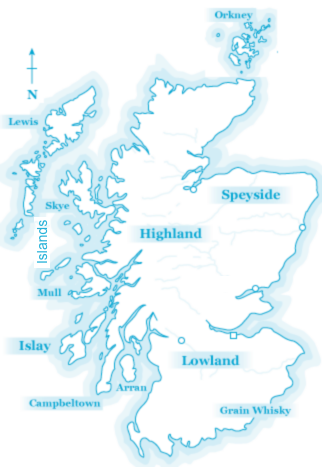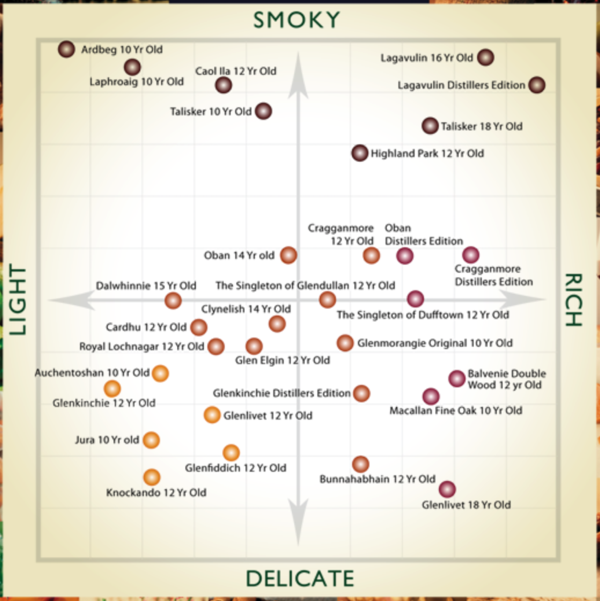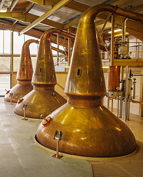|
Types |
Regions |
Ratings |
Distilling Process |
Types:
Scotch - A whiskey distilled from water and malted barley.
Scotch is generally of two types Blended and Single Malt.
Grain Whiskey is another type primarily used to make blended whiskeys. In addition to water and malted barley, it may also be produced from whole grains of other malted or unmalted cereals.
Scotch is classified by regions where they are produced. The official list of regions is established by the Scotch Whisky Association (SWA) and has changed over time. e.g. Speyside was part of Highlands but is now a separate region; Campbeltown has been in and out of the list. Islands is considered a separate region by many, but SWA considers it part of the Highlands.
Blended: The average blended whisky is 60%-85% grain whisky.
Bells, Dewar's, Johnnie Walker, Cutty Sark, J&B, The Famous Grouse, Chivas Regal, pinch and others. Dewar's in the highlands, basically invented the modern blended whisky.
Single Malt: (number of distilleries)

- Highland: (35) They are generally aromatic, smooth and medium bodied, with palates that range from lushly complex to floral delicacy. The subregions of the Highlands include:
- North, East and West Highlands - Dalmore, Dalwhinnie, Oban, Glen Ord, Glenmorangie, Glengoyne, Clynelish and others.
- The Orkney Isles - Highland Park
- The Western Islands (Arran, Jura, Mull, and Skye) - Talisker, Arran.
- Islands
Islands is considered a separate region by many, but SWA considers it part of the Highlands.
Due to the location of the Islands distilleries their whiskies tend to have a coastal feel to them. They are slightly more peaty in character than most highland malts but not to the extent of peatiness that you will find in Islay malts. The peatiness is generally softer and sweeter than there stronger cousins from Islay.
- Speyside (48) - (Region in Northern Highlands, east of Inverness). Stylistically, Speysides vary from the light, soft, floral nature of whiskies like Knockando and Cardhu to weighty, more complex and heavily sherried malts such as Mortlach and The Macallan.
For many aficionados, Speyside is the whisky region. It is to malt, as Cognac is to brandy.
Others: Balvenie, Cardhu, Glenfiddich, The Glenlivet, The Macallan, Cragganmore, Singleton of Auchroisk, Aberlour and others.
- Islay (8) is an island off the west coast. Traditional Islay malt whiskies are intensely, and peaty and pungent in character with a distinctive iodine or medicinal tang that is said to come from sea salt permeating the local peat that is used to dry the barley malt.
Lagavulin
- Campbeltown (3) is a port located on the tip of the Kintyre Peninsula on the southwest coast that has its own distinctive spicy and salt-tinged malt whiskies. Once the 'whisky capital' of Scotland, with no fewer than 21 working distilleries during the 1880s.
Springbank remains a classic malt with a worldwide reputation for excellence.
- The Lowlands (3) encompass the entire Scottish mainland south of the Highlands except the Kintyre Peninsula where Campbeltown is located. Lowland malt whiskies are light bodied, relatively sweet, and delicate.

Source:BeaBetterBartender.com
In 1988, Diageo, the world's largest producer of spirits, defined six 'Classic Malts' to represent the differing tastes and characteristics of Single Malt Whiskies. They include:- Dalwhinnie and Oban (highlands), Cragganmore (speyside), Glenkinchie (lowland), Lagavulin (Islay), and Talisker (islands).
They've now created a new web site Malts.com adding the following to their classics list: Caol Ila (Islay), Cardhu, Knockando, The Singleton of Glendullan, Glen Elgin (Speyside), Clynelish, Royal Lochnagar (Highlands).
There is nothing unique about these that make them classic it just seems to be a marketing tool for Diageo.
Whisky Ratings & Reviews For Peat Sake!
|
98 wilson & morgan caol ila 15 year old
cask strength (1990)
95 talisker distiller's edition
94 glenmorangie 15 years old sauternes wood finish
91 talisker 25 year old
91 lagavulin distiller's edition 15 years old
90 The macallan fine oak 18 years old
90 glenfiddich caoran reserve 12 years old
90 aberlour a'bunadh
88 the macallan 18 years old
87 glengoyne 17 years old
87 lagavulin 12 year old natural cask strength
87 glenkinchie distillers edition
87 the glenlivet 16 year old nadurra
86 the macallan 10 years old cask strength
86 the macallan 12 years old
86 glengoyne 15 years old scottish oak wood finish
|
85 the macallan fine oak 15 years old
85 the glenlivet 21 years old
83 cragganmore 1991 distillers edition
82 the macallan cask strength
82 the glenlivet 12 years old
82 glenfiddich ancient reserve 18 years old
80 arran malt cru bourgogne finish
80 the glenlivet 18 years old
80 oban 14 year old
79 cragganmore 12 years old
78 dalwhinnie 15 years old
78 glenkinchie 10 years old
77 the glenlivet nadurra 16 year old (06 2006)
76 cragganmore 10 year old cask strength
72 glenfiddich gran reserva 21 years old
71 the macallan 10 years old
67 aberlour 10 year old
|
Scotch meisters Top 10 Whisky Lists
Number of recommendations:
Links:
Scotch Whisky Association - Map of Distilleries
Whisky Regions
ScotlandWhisky.com Map of Scotch Whisky distilleries, whisky tours
Expert Liquor Reviews, | Distiller
Scotch Whisky Facts, Scotch Whisky Ratings and Scotch Whisky Reviews at tastings.com
Scotch whisky - Wikipedia, the free encyclopedia
Distilling Process:
- Barley is steeped in water for about a day.
- Then spread out on floors in the Mault Barn.
It is turned every few hours for six to seven days until it just starts to germinate. This starts breaking down the starch into fermentable sugars.
- It is then placed in a kiln to dry it and halt the germination. Smoke from the peat fired furnaces billow up through a mesh floor giving it the smokey taste. Damp malt is usually dried for 18 - 42 hours. Some use peat for the first 18 hours then hot air to finish it.
- The malted barley is then milled into grist.
- The grist then goes to the Mash House, where it’s added to hot water in huge copper kettles (Mash Tun) to produce a sugary liquid called wort.
It is then drained and mashed two more times.
- It is added to Pine Washbacks and yeast is added. After about two days they are left with a fermented liquid is known as wash. It tastes and smells very similar to a strong malty beer with an ABV of about 8%.

- This is heated in Wash Stills (great copper kettles) and the alcoholic vapor is condensed into liquid called Low Wine, at about 22% ABV.
- A second destillation is carried out in the smaller Spirit Still, where the Stillman draws off the the vapours in the three parts: Foreshots, Heart Of The Run and Feints. Clear like water but with an ABV of 69%, the Heart Of The Run is the only cut which is used.
- Some transfer the whiskey to a different cask for the last few years of maturation.
See Our Process | Bowmore Single Malt Scotch Whisky
and Nearly Everything You Need To Know About Scotch
Factors affecting taste:
Scotch is made from just three ingredients, barley, yeast and water.
The basic character of a whisky is shaped by the special distillation and the malt that has been used.
Taste is enhanced when the malt is dried, typically over peat fires.
It is further enhanced by the type of cask used during maturation and the maturation time.
Peat:
Large parts of Scotland are covered with peat bogs. These peat layers have been formed over a period of 1000 to 5000 years by decayed vegetation and can be up to several meters thick.
Peat is cut in small slices and piled up into small pyramids for drying. The water drains off the peat very fast and turns the soft slices into hard briquettes. Similar to coal, these briquettes contain the energy of the dead plants.
The level of smokiness of a whisky is determined by the time the barley grain is exposed to the pungent peat smoke during drying.
Ecology -
The whisky industry tries to reduce peat consumption with several methods.
Some grind the peat into a gritty powder that is put on normal fire and produces the required smoke.
Others use closed systems where the smoke is led over the barley grains several times until it is properly exploited.
Maturation:
New make whisky has a tangy, metallic taste.
With increasing maturation time, this unwanted taste diminishes more and more along the red line. After 5 to 8 years it is usually gone.
With increasing maturation time the whisky takes up flavours from the cask. Initially it's a general wood flavour but especially vanilla, toffee and oak
Casks:
Because single malt Scotch whisky is too delicate to mature in new oak casks, they use a variety of used casks.
The Irish mature the majority of their whiskey in Ex-Bourbon barrels from the US. The American oak makes the whiskey smooth and a bit mellow.
Some of the special bottlings are stored in the more expensive Ex-Sherry or other wine casks. The wine casks are usually made of European oak. The flavours are more intense and sometimes bitter from the tannins but also more fruity from the residue of the wine in the porous oak.
But there's a trick, namely ‘finishing’. First the whisky is matured in normal American casks until its immaturity has reduced and it has already taken on a basic aroma. 8 to 10 years are enough for that. Then the whisky is filled into European oak casks that held various wines before.
See Introduction to the Cask Maturation of Whisky - Whisky.com
Mixed Drinks with Scotch, Drambuie and Glayva
Rob Roy or Thistle (a Scotch Manhattan)
1 1/2 oz Scotch
1/4 oz sweet vermouth
Angostura bitters (or Peychaud's †) (optional)
Combine the scotch, sweet vermouth and dry vermouth in a mixing glass
half-filled with ice cubes. Stir well, strain into a cocktail glass,
and garnish with a maraschino cherry or a lemon twist.
Dry Rob Roy - made with dry vermouth.
Perfect Rob Roy - made with equal parts sweet and dry vermouth.
Bobby Burns
There are two recipes for the Bobby Burns.
2 ounces blended Scotch whisky
1 ounce Italian (sweet) vermouth
1 dash Angostura bitters (or if you have Peychaud's on hand, give that a spin)
2 dashes Drambuie® OR Bénédictine
Note: Some recipes call 1/2 oz. of Drambuie
Stir with ice and strain into a cocktail glass;
twist a piece of lemon peel over the drink, and add the twist as garnish.
In "The Fine Art of Mixing Drinks", David Embury says:
"Peychaud's tends to marry better with Scotch"
† I went 4 liquor stores and none had Peychaud's,
Search at www.wine-searcher.com
See:
Bobby Burns at CocktailChronicles.com
Bobby Burns at DrinksMixer.com
In "A Birthday Toast to Scotland's Bard" (WSJ Jan. 23, 2009) they say:
The peculiar habit among Americans to call Burns "Bobby" (or "Bobbie")
has long been an object of derision.
Ogden Nash proclaimed in the New Yorker:
He would no more speak of Tommy Hardy or Bernie Shaw.
His 1951 Poem "Everything's Haggis in Hoboken" says
"And I yearn to shatter a set of crockery/On this condescending Bobbie-sockery."
Glasgow
1 1/2 oz Scotch whisky
1 tbsp dry vermouth
1 tbsp lemon juice
1 tbsp almond extract
Combine ingredients in a cocktail shaker with ice.
Shake and strain into an old fashioned glass.
The Highland Cream
1 oz Scotch whisky
1/2 oz white creme de cacao
1/4 oz peppermint schnapps
1/4 oz Galliano® herbal liqueur
1 tsp Glayva® Scotch liqueur *
1 oz whipping cream
Shake and strain into an ice-filled old-fashioned glass, and serve.
* I couldn't find Glayva at any stores. It wasn't in their catalogue either.
The only US source I found was Wine Globe.
Drambuie® drinks:
Drambuie on ice
Rusty Nail
1 1/2 oz Scotch whisky
1/2 oz Drambuie® Scotch whisky (Some call for a 1:1 ratio)
1 twist lemon peel
Pour the scotch and drambuie into an old-fashioned glass almost filled
with ice cubes. Stir well. Garnish with the lemon twist.
Espresso Martini Cocktail
Shake 2 parts Drambuie,
1 part Crème de Cacao,
2 parts strong espresso and
pour into a pre-chilled martini glass.
Dust with cinnamon.
Clansmen's Christmas Toddy
1 part Drambuie
2 parts cider
2 parts boiling water
Add 3 squeezes of lemon
Garnish with lemon and cinnamon stick.
Drambuie recipes at cocktails.suite101.com
Drambuie_recipes at drambuie.com
Glayva drinks
Glayva blush: Cranberry, chrushed ice and lime.
Glayva gold: Ginger Ale, chrushed ice and lime.
Highland Latte: Expresso, water, brown sugar, layer of fresh cream and
a dram of Glayva
Glayva on the rocks.
* I couldn't find Glayva at any stores. It wasn't in their catalogue either.
The only US source I found was Wine Globe.
Links:
Other Scotch based drinks at DrinksMixer.com
Drambuie Cocktail Recipes at cocktails.suite101.com
Drambuie is a Registered Trademark Of The Drambuie Liqueur Co. Ltd.
last updated 29 Sep 2010
|
 Food-Drinks
Food-Drinks
 Drinks
Drinks
 Scotch Whiskey
Scotch Whiskey


